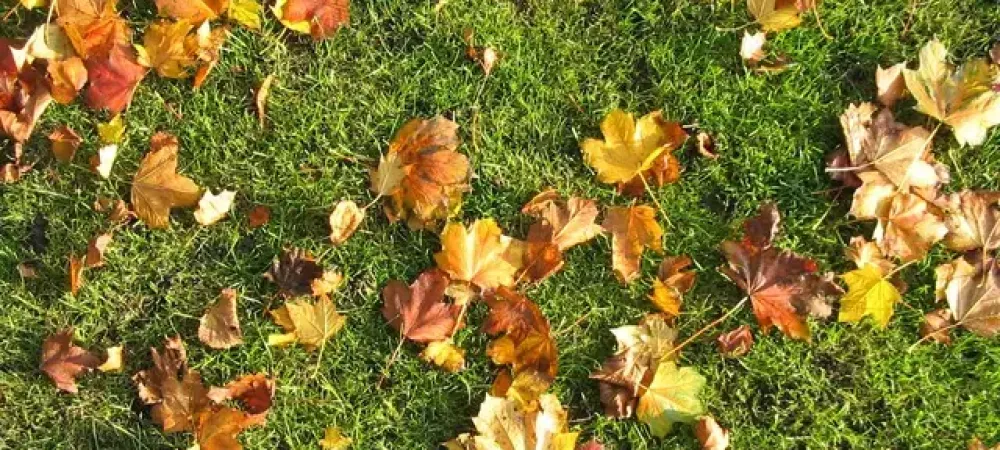Appropriate Leaf Cover When Fertilizing Your Lawn

Fall has officially arrived and with it comes the familiar fall lawn care chores: winterizing the sprinklers, storing the lawn furniture, winterizing the lawnmower, and (everyone’s favorite) raking. Preparing your lawn for winter is an important job and, with our lawn care program, includes winterizing fertilizer. But, do the leaves get in the way? What is the appropriate leaf cover when fertilizing a lawn?
What is fall fertilizer?
Here in New Hampshire, our lawns are all made up of cool-season grasses like Kentucky bluegrass, perennial ryegrass, and tall fescue. In the fall, as the temperatures start to drop, these grasses wake up and start growing again. That’s why fall fertilization is so important.
Upon request, here at Alliance Landscaping, our lawn care technicians will provide your lawn with a winterizing fertilizer that encourages root growth. This will make the grass stronger and more resilient to the frigid cold of winter. The small fertilizer pellets are spread throughout the lawn, where they fall down to the soil and are dissolved with water. The nutrients are then absorbed into the root system of your grass.
Do leaves block fall fertilizers?
Staying on top of your leaf-raking can feel like a full-time job every fall. If you have a lawn care program it can feel more urgent to remove the leaves so they don’t block the fertilizer from reaching your grass. The good news is that there is an appropriate level of leaf cover when fertilizing your lawn.
The general guideline we follow is that as long as the grass is visible between the leaves, and the leaves are not matted down and wet, then applying fertilizer is fine. Fertilizer pellets don’t stick to leaves for very long. Before long, they roll off the leaves and down to the soil where they belong.
When Is Leaf Cover Inappropriate For Fertilizers?
While there is an appropriate leaf cover for your lawn when applying fertilizer, there is also an inappropriate leaf cover. Having too many leaves on your lawn can cause a lot of problems for your grass. Here are a few things to watch for:
Wet and Matted Leaves
If the leaves on your lawn are wet and matted down, then it’s time to get the rake out. Wet leaves are the perfect environment for mold and fungus to grow. If leaves are too wet for too long, then the fertilizer will stick to the leaves and have trouble rolling off to the soil below.
Matted leaves are never good for lawns and should be removed regardless of any fertilizer schedule you may have. Heavy, matted leaves press your grass down, suffocating the turf and blocking any sunlight from getting through.
Piles of Leaves
Having one or two small piles on the corner of your property isn’t an issue for fall fertilizer. However, if you have multiple large piles of leaves throughout your lawn, then some areas of grass will not be fertilized.
Heavy piles of leaves will block the sunlight from reaching the grass beneath and can cause patches of grass to decline or even die. These dead or struggling areas will be perfect spots for opportunistic weeds to take root.
Total Leaf Coverage
If your lawn is completely covered by leaves, with no grass visible, then fertilizer won’t be able to reach the turf. Before a scheduled fertilizer application, check your leaf coverage. If you can’t see any grass through the blanket of leaves, then you’ll need to remove the leaves. In addition, our trained technicians will identify whether or not the lawn is available to treat with fertilizer. If conditions are not favorable then we will reschedule. It’s good to avoid total leaf coverage because leaves are the perfect environment for lawn pests like fleas and ticks.
Need help with your fall lawn care? Call the professionals.
Here at Alliance Landscaping, we know that yearly lawn care isn’t finished until the snow starts to fall. If you’re looking for fertilizer applications, sprinkler system winterization, or fall broadleaf weed control, then we have the solutions for you. Give us a call at (603) 704-4230.
